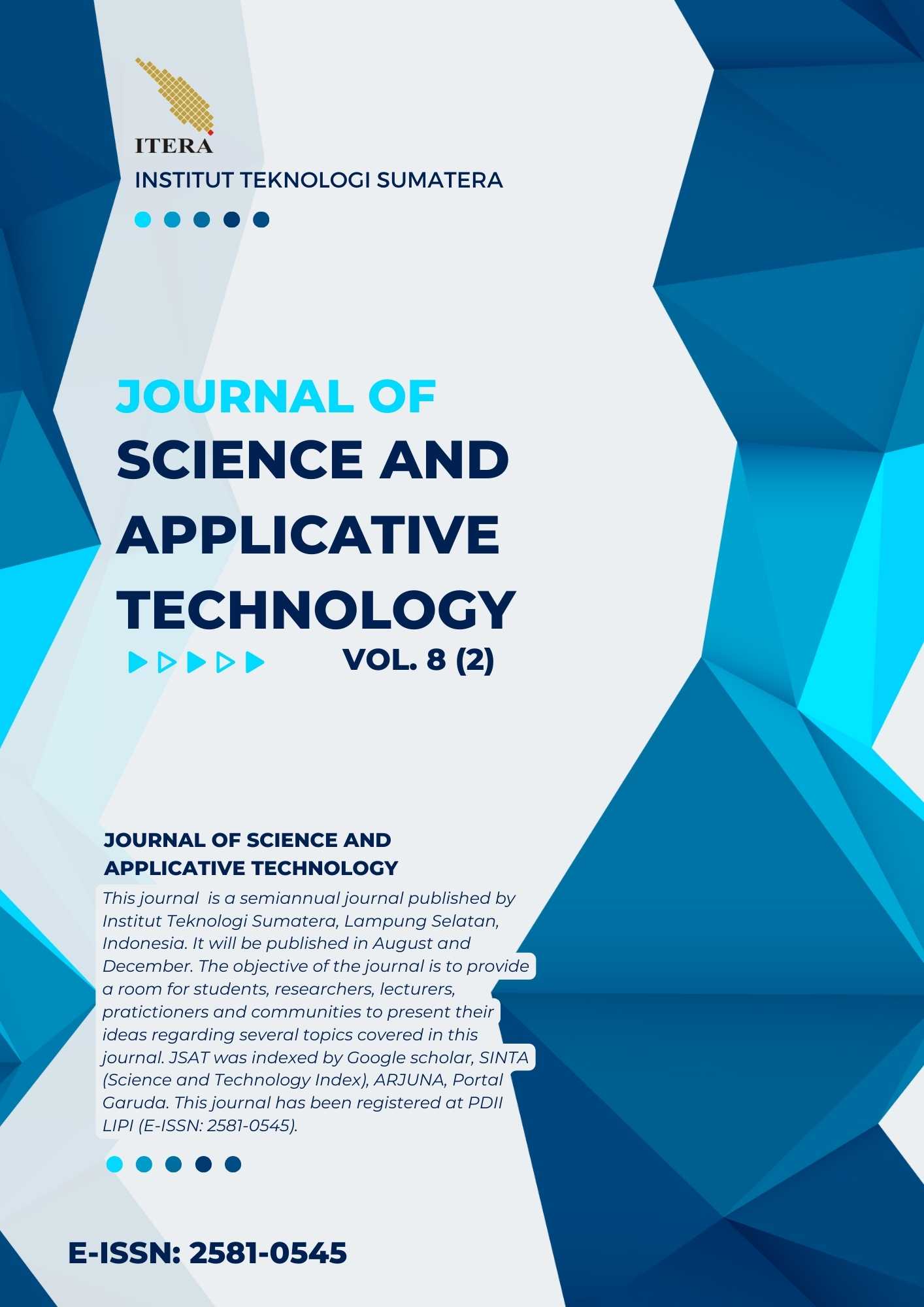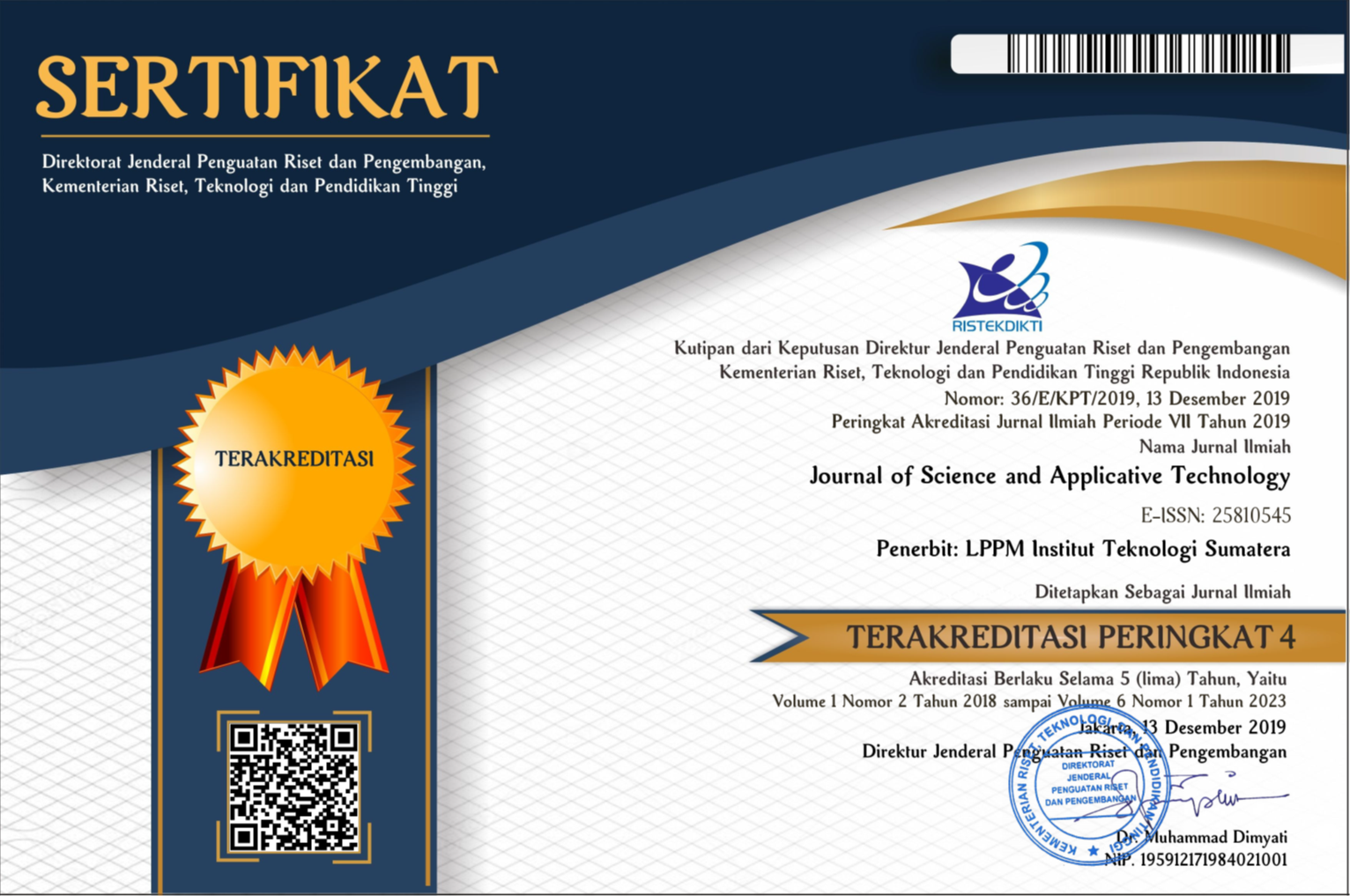Regional Validation Coastal Sea Level Anomaly Estimation from Altimetry Satellite and Tide Gauges Data using Fuzzy Inference System: A Case Study Around Natuna Seas
Abstract
The validation of waveform retracking analyses with Fuzzy Inferences system, which was previously developed to optimize the estimation of sea surface height (SSHs), particularly in coastal locations, is presented in this study. The fuzzy inference system has been tested and validated in the Natuna Sea, Indonesia, where altimetry waveforms varied based on water conditions. Validation was performed by comparing the waveform retracking result of Jason-3 data with in-situ tide gauge data and geoid. The validation of waveform retracking data for sea level anomaly (SLA) estimate against tidal data demonstrates that the waveform retracking with a fuzzy inference system is more accurate than previous approaches. Waveform retracking with fuzzy inference system is able to produce an average temporal correlation of 0.75-0.89 and RMSE between 0.15-0.17 m. The waveform retracking combined with a fuzzy inference system can improve SLA estimation accuracy in nearshore up to 4 km from the coastline. The results indicate that retracking with fuzzy inference system has the potential to be used in other complicated oceans.
Downloads
References
[2] J. Benveniste, “Radar Altimetry: Past, Present and Future,” in Coastal Altimetry, S. Vignudelli, A. G. Kostianoy, P. Cipollini, and J. Benveniste, Eds., Berlin: Springer, 2011, ch. 1, pp. 1–17. doi: 10.1007/978-3-642-12796-0.
[3] C. Birkett, C. Reynolds, B. Beckley, and B. Doorn, “From Research to Operations: The USDA Global Reservoir and Lake Monitor,” in Coastal Altimetry, S. Vignudelli, A. G. Kostianoy, P. Cipollini, and J. Benveniste, Eds., Berlin: Springer, 2011, ch. 2, pp. 19–50. doi: 10.1007/978-3-642-12796-0.
[4] R. S. Nerem and G. T. Mitchum, “Sea Level Change,” in Satellite Altimetry and Earth Sciences. A Handbook of Techniques and Applications, L.-L. Fu and A. Cazenave, Eds., San Diego (US): Academic Press, 2001, ch. 8, pp. 329–349.
[5] D. B. Chelton, J. C. Ries, B. J. Haines, L.-L. Fu, and P. S. Callahan, “Satellite Altimetry,” in Satellite Altimetry and Earth Sciences. A Handbook of Techniques and Applications, L.-L. Fu and A. Cazenave, Eds., San Diego (US): Academic Press, 2001, pp. 1–131.
[6] L.-L. Fu and A. Cazenave, Satellite altimetry and Earth sciences. A Handbook of Techniques and Applications, vol. 338, no. 2. San Diego (US): Academic Press, 2001. doi: 10.1016/0019-1035(80)90096-2.
[7] G. S. Brown, “The Average Impulse Response of a Rough Surface and Its Applications,” IEEE Journal of Oceanic Engineering, vol. 2, no. 1, pp. 67–74, 1977, doi: 10.1109/JOE.1977.1145328.
[8] M. Passaro, P. Cipollini, S. Vignudelli, G. D. Quartly, and H. M. Snaith, “ALES: A multi-mission adaptive subwaveform retracker for coastal and open ocean altimetry,” Remote Sensing of Environment, vol. 145, no. April, pp. 173–189, 2014, doi: 10.1016/j.rse.2014.02.008.
[9] R. Roscher, B. Uebbing, and J. Kusche, “STAR: Spatio-temporal altimeter waveform retracking using sparse representation and conditional random fields,” Remote Sensing of Environment, vol. 201, no. October 2016, pp. 148–164, 2017, doi: 10.1016/j.rse.2017.07.024.
[10] J. Gómez-Enri, C. P. Gommenginger, M. A. Srokosz, P. G. Challenor, and J. Benveniste, “Measuring global ocean wave skewness by retracking RA-2 Envisat waveforms,” Journal of Atmospheric and Oceanic Technology, vol. 24, no. 6, pp. 1102–1116, 2007, doi: 10.1175/JTECH2014.1.
[11] C. Gommenginger et al., “Retracking altimeter waveforms near the coasts,” in Coastal Altimetry, S. Vignudelli, A. Kostianoy, P. Cipollini, and J. Benveniste, Eds., Berlin: Springer, 2011, ch. 4, pp. 61–101.
[12] T. V. Martin, H. J. Zwally, A. J. Brenner, and R. A. Binschadler, “Analysis and Retracking of Continental Ice Sheet Radar Altimeter Wavefor,” Journal of Geophysical Research, vol. 88, no. C3, pp. 1608–1616, 1983, doi: 10.1029/JC088iC03p01608.
[13] M. Anzenhofer, C. K. Shum, and M. Rentsh, “Coastal altimetry and applications,” Ohio State University Geodetic Science and Surveying Tech. Rep, vol. 464, no. 464, p. 36, 1999.
[14] X. Deng and W. E. Featherstone, “A coastal retracking system for satellite radar altimeter waveforms: Application to ERS-2 around Australia,” Journal of Geophysical Research: Oceans, vol. 111, no. 6, pp. 1–16, 2006, doi: 10.1029/2005JC003039.
[15] D. J. Wingham, C. G. Rapley, and H. Griffiths, “New Techniques in Satellite Altimeter Tracking Systems.,” Digest - International Geoscience and Remote Sensing Symposium (IGARSS), no. September, pp. 1339–1344, 1986.
[16] C. H. Davis, “A robust threshold retracking algorithm for measuring ice-sheet surface elevation change from satellite radar altimeters,” IEEE Transactions on Geoscience and Remote Sensing, vol. 35, no. 4, pp. 974–979, 1997, doi: 10.1109/36.602540.
[17] C. Hwang, J. Guo, X. Deng, H. Y. Hsu, and Y. Liu, “Coastal gravity anomalies from retracked Geosat/GM altimetry: Improvement, limitation and the role of airborne gravity data,” Journal of Geodesy, vol. 80, no. 4, pp. 204–216, 2006, doi: 10.1007/s00190-006-0052-x.
[18] L. Bao, Y. Lu, and Y. Wang, “Improved retracking algorithm for oceanic altimeter waveforms,” Progress in Natural Science, vol. 19, no. 2, pp. 195–203, 2009, doi: 10.1016/j.pnsc.2008.06.017.
[19] H. Lee et al., “Validation of Jason-2 altimeter data by waveform retracking over California coastal ocean,” Marine Geodesy, vol. 33, no. November 2014, pp. 37–41, 2010, doi: 10.1080/01490419.2010.488982.
[20] A. Halimi, C. Mailhes, J. Y. Tourneret, P. Thibaut, and F. Boy, “Parameter estimation for peaky altimetric waveforms,” IEEE Transactions on Geoscience and Remote Sensing, vol. 51, no. 3, pp. 1568–1577, 2013, doi: 10.1109/TGRS.2012.2205697.
[21] J. Y. Guo, Y. G. Gao, C. W. Hwang, and J. L. Sun, “A multi-subwaveform parametric retracker of the radar satellite altimetric waveform and recovery of gravity anomalies over coastal oceans,” Science China Earth Sciences, vol. 53, no. 4, pp. 610–616, 2010, doi: 10.1007/s11430-009-0171-3.
[22] L. Yang, M. Lin, Q. Liu, and D. Pan, “A coastal altimetry retracking strategy based on waveform classification and sub-waveform extraction,” International Journal of Remote Sensing, vol. 33, no. 24, pp. 7806–7819, 2012, doi: 10.1080/01431161.2012.701350.
[23] P. A. M. Berry, “Topography from land radar altimeter data: Possibilities and restrictions,” Physics and Chemistry of the Earth, Part A: Solid Earth and Geodesy, vol. 25, no. 1, pp. 81–88, 2000, doi: 10.1016/S1464-1895(00)00014-4.
[24] N. H. Idris and X. Deng, “An Iterative Coastal Altimetry Retracking Strategy Based on Fuzzy Expert System for Improving Sea Surface Height Estimates,” in IGARSS, 2013, pp. 2954–2957.
[25] C. S. Hamsa, K. D. Kanniah, F. M. Muharam, N. H. Idris, Z. Abdullah, and L. Mohamed, “Textural measures for estimating oil palm age,” International Journal of Remote Sensing, vol. 40, no. 19, pp. 7516–7537, 2019, doi: 10.1080/01431161.2018.1530813.
[26] R. D. Permana, B. Nababan, and J. P. Panjaitan, “Waveform re-tracking analyses with Fuzzy Logic on altimetry satellite data in Natuna Waters,” IOP Conference Series: Earth and Environmental Science, vol. 429, no. 1, pp. 0–14, 2020, doi: 10.1088/1755-1315/429/1/012042.
[27] R. Pawlowicz, R. Pawlowicz, R. C. Beardsley, R. Beardsley, S. Lentz, and S. Lentz, “Classical tidal harmonic analysis including error estimates,” in MATLAB using T TIDE. Computers & Geosciences, vol. 28, no. 8, 2002.
[28] Y. Yang, C. Hwang, H. J. Hsu, E. Dongchen, and H. Wang, “A subwaveform threshold retracker for ERS-1 altimetry: A case study in the Antarctic Ocean,” Computers and Geosciences, vol. 41, pp. 88–98, 2012, doi: 10.1016/j.cageo.2011.08.017.
[29] N. H. Idris and X. Deng, “An Iterative Coastal Altimetry Retracking Strategy Based on Fuzzy Expert System for Improving Sea Surface Height Estimates,” in IGARSS, 2013, pp. 2954–2957.
[30] A. Huang, R. Shen, W. Di, and H. Han, “A methodology to reconstruct LAI time series data based on generative adversarial network and improved Savitzky-Golay filter,” International Journal of Applied Earth Observation and Geoinformation, vol. 105, 2021, doi: 10.1016/j.jag.2021.102633.
[31] C. S. Hamsa, K. D. Kanniah, F. M. Muharam, N. H. Idris, Z. Abdullah, and L. Mohamed, “Textural measures for estimating oil palm age,” International Journal of Remote Sensing, vol. 40, no. 19, pp. 7516–7537, 2019, doi: 10.1080/01431161.2018.1530813.
Copyright (c) 2025 Journal of Science and Applicative Technology

This work is licensed under a Creative Commons Attribution-NonCommercial 4.0 International License.
All the content on Journal of Science and Applicative Technology (JSAT) may be used under the terms of the Creative Commons Attribution-NonCommercial 4.0 International License.
You are free to:
- Share - copy and redistribute the material in any medium or format
- Adapt - remix, transform, and build upon the material
Under the following terms:
- Attribution - You must give appropriate credit, provide a link to the license, and indicate if changes were made. You may do so in any reasonable manner, but not in any way that suggests the licensor endorses you or your use.
- NonCommercial - You may not use the material for commercial purposes.
- No additional restrictions - You may not apply legal terms or technological measures that legally restrict others from doing anything the license permits.





















